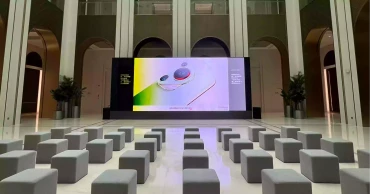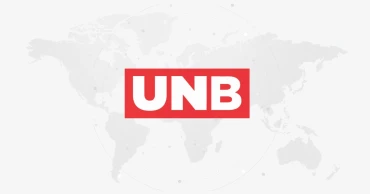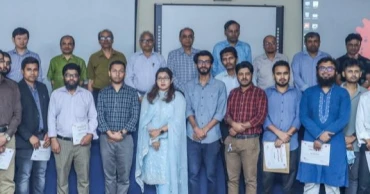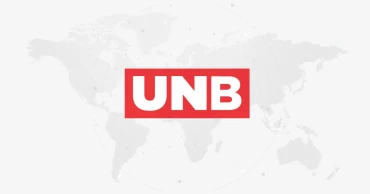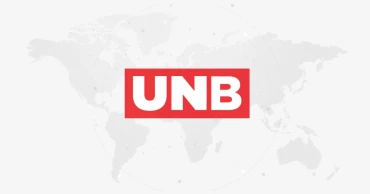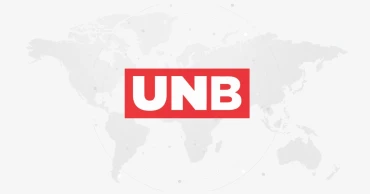Huawei
Huawei's tri-foldable phone hits global markets despite US curbs
Huawei on Tuesday held a global launch for the industry’s first tri-foldable phone, which analysts said marked a symbolic victory for the Chinese tech giant amid U.S. technology curbs. But challenges over pricing, longevity, supply and app constraints may limit its success.
Huawei said at a launch event in Kuala Lumpur that the Huawei Mate XT, first unveiled in China five months ago, will be priced at 3,499 euros ($3,662). Although dubbed a trifold, the phone has three mini-panels and folds only twice. The company says it's the thinnest foldable phone at 3.6 millimeters (0.14 inches), with a 10.2-inch screen similar to an Apple iPad.
“Right now, Huawei kind of stands alone as an innovator" with the trifold design, said Bryan Ma, vice president of device research with the market intelligence firm International Data Corporation.
Huawei reached the position despite “not getting access to chips, to Google services. All these things basically have been huge roadblocks in front of Huawei,” Ma said, adding that the “resurgence we're seeing from them over the past year has been quite a bit of a victory."
Huawei, China’s first global tech brand, is at the center of a U.S.-China battle over trade and technology. Washington in 2019 severed Huawei’s access to U.S. components and technology, including Google’s music and other smartphone services, making Huawei's phone less appealing to users. It has also barred global vendors from using U.S. technology to produce components for Huawei.
American officials say Huawei is a security risk, which the company denies. China’s government has accused Washington of misusing security warnings to contain a rising competitor to U.S. technology companies.
OPPO Reno13 Pro 5G Review: Is It Worth the Hype?
Huawei launched the Mate XT in China on Sept. 20 last year, the same day Apple launched its iPhone 16 series in global markets. But with its steep price tag, the Mate XT “is not a mainstream product that people are going to jump for,” Ma said.
At the Kuala Lumpur event, Huawei also unveiled its MatePad Pro tablet and Free Arc, its first open-ear earbuds with ear hooks and other wearable devices.
While Huawei’s cutting-edge devices showcase its technological prowess, its long-term success remains uncertain given ongoing challenges over global supply chain constraints, chip availability and limitations on the software ecosystem, said Ruby Lu, an analyst with the research firm TrendForce.
"System limitations, particularly the lack of Google Mobile Services, means its international market potential remains constrained,” Lu said.
IDC's Ma said Huawei dominated the foldable phone market in China with 49% market share last year. In the global market, it had 23% market share, trailing behind Samsung's 33% share in 2024, he said. IDC predicted that total foldable phone shipments worldwide could surge to 45.7 million units by 2028, from over 20 million last year.
Lenovo Yoga Slim 7i Aura Edition Review: A True MacBook Competitor or Just Hype?
While most major brands have entered the foldable segments, Lu said Apple has yet to release a competing product.
“Once Apple enters the market, it is expected to significantly influence and stimulate further growth in the foldable phone sector,” Lu added.
10 months ago
Honor X7c Review: A Budget-friendly Powerhouse for Everyday Use
The Honor X7c, released on October 18, 2024, is another addition to Huawei’s sub-brand Honor's mid-range X series. With improved hardware, modern features, and a sleek design, it competes fiercely with rivals. Let’s dive into a detailed review of Honor X7c’s key specs, price, pros, cons, and see how it stacks up.
Key Features of Honor X7c
.
Design and Build Quality
The Honor X7c boasts a slim profile, 166.9 mm by 76.8 mm by 8.1 mm, and a 194-196 g weight. Its ergonomic design features a polycarbonate body with a glossy finish and IP64 water and dust resistance, making it stylish and durable.
Compared to the Honor X7b, which is slightly thicker and heavier (199 g), the X7c feels more refined to hold. Compared to competitors like the Xiaomi Redmi Note 13, which has a premium Gorilla Glass 5 front, the X7C’s tempered glass display falls short but remains excellent for its price.
Read more: realme GT7 Pro Review: Speed, Style, and Gaming Excellence at a Competitive Price
Display Quality
The X7c features a 6.77-inch IPS LCD with a 120Hz refresh rate and a resolution of 720 by 1610 pixels (~261 PPI). While the refresh rate ensures smoother scrolling and transitions, the HD+ resolution is somewhat underwhelming.
In contrast, the Xiaomi Redmi Note 13 offers a superior AMOLED display with 1080 by 2400 pixels resolution, delivering sharper visuals and vibrant colours. The Honor X7b has a 90Hz refresh rate, which is lower than the X7c, but it offers 1080p resolution for crisper details. The Oppo A92, with its 1080 by 2400 pixels IPS LCD, also outperforms the X7c in clarity, though it lacks the higher refresh rate.
Camera Performance
The Honor X7c comes with a dual rear camera setup, including a 108MP (f/1.8) primary sensor and a 2MP (f/2.4) depth sensor, alongside an 8MP (f/2.0) front camera. The primary sensor captures impressive detail in well-lit conditions, though low-light performance introduces noticeable noise.
Read more: ZTE Blade A55 Review: Affordable Excellence with Modern Features
Compared to the Honor X7b, which features a triple camera setup with an ultrawide lens, the X7c lacks versatility. The Xiaomi Redmi Note 13 also edges ahead with a similar 108MP primary sensor but includes an 8MP ultrawide lens, offering more flexibility for photography. The Oppo A92, though older, delivers decent shots with its quad-camera setup, including a 48MP primary sensor and ultrawide and macro capabilities.
Offering a maximum video capture of 4k at 30fps, Oppo A92 steps ahead of Honor X7c and Xiaomi Redmi Note 13, as they can shoot 1080p at 30fps footage at best.
Processor Performance
The Honor X7c is powered by the Qualcomm Snapdragon 685 (6nm) chipset, featuring an octa-core CPU (4x2.8 GHz Cortex-A73 and 4x1.9 GHz Cortex-A53) and an Adreno 610 GPU. This configuration ensures smooth performance for everyday tasks, like browsing, streaming, and multitasking.
Read more: Walton NexG N74 Review: A Competitive Budget-friendly Smartphone Worth Considering
Honor X7b offered the Snapdragon 680 chipset, but the X7c offers higher clock speeds for faster processing. The Oppo A92, using the older Snapdragon 665, lags in terms of processing power. On the other hand, the Xiaomi Redmi Note 13 outshines with its MediaTek Dimensity 6080 chipset, which delivers better performance, especially for demanding tasks.
Software and User Interface
The Honor X7c runs on Android 14 with MagicOS 8, providing a clean and intuitive interface with minimal bloatware. Features like split-screen multitasking and one-handed mode add to its usability.
Though the Honor X7b also runs MagicOS 8, there are a few noticeable differences with X7c. The Xiaomi Redmi Note 13 introduces HyperOS, offering better customization and performance optimizations. The Oppo A92, limited to Android 10 with ColorOS 7.1, feels outdated in comparison.
Read more: vivo V40 Lite Review: A Stylish Performer or Just Another Mid-Range Option?
Storage Options
The X7c offers two configurations: 128GB with 6GB RAM and 256GB with 8GB RAM, ensuring ample space for apps, media, and multitasking. However, the lack of a dedicated microSD card slot is a downside for users needing expandable storage.
The Honor X7b provides similar storage options but includes microSD support, giving it an edge. The Xiaomi Redmi Note 13 and Oppo A92 both offer expandable storage, with the Redmi Note 13 supporting up to 512GB.
Gaming Performance
The X7c handles casual games like Candy Crush and Free Fire with ease, thanks to its 120Hz refresh rate and optimized GPU. While playing heavier titles like PUBG Mobile and Call of Duty: Mobile, it performs adequately on medium settings, though frame drops may occur during prolonged sessions.
Read more: vivo iQoo Neo9s Pro Review: The Mid-Range Gaming Powerhouse You’ve Been Waiting For?
Compared to the Honor X7b, the X7c’s slightly upgraded chipset offers a marginal improvement in gaming. However, the Xiaomi Redmi Note 13 stands out as a better gaming device, courtesy of its more powerful GPU. The Oppo A92 struggles to keep up with modern games, making the X7c a preferable choice for casual gaming.
Battery Life
The X7c comes with a 5200 or 6000mAh battery (depending on the region) and supports 35W fast charging. This ensures more than a day of moderate usage and quick recharging times.
In comparison, the Honor X7b offers similar battery capacity but charges at the same speed, making them nearly identical in this aspect. The Xiaomi Redmi Note 13 has a smaller 5000mAh battery with 33W charging, while the Oppo A92 offers a 5000mAh battery with a slower 18W charging. The X7c’s combination of large battery capacity and fast charging places it ahead of its rivals in longevity.
Read more: Tecno Spark 30 Pro Review: Power-packed Performance at a Budget-friendly Price
Pros and Cons of Honor X7c
Pros
- IP64 dust and water resistance- 6.77-inch display with 120Hz refresh rate- Snapdragon 685 processor- 108MP main camera- 5200-6000mAh battery with 35W fast charging- Android 14 with MagicOS 8.
Cons
- Display resolution is only HD+, not Full HD- No ultrawide lens for versatile photography- No microSD card slot- Limited low-light camera performance- The plastic body feels less premium- No 5G support- No reverse charging support- No wireless charging support.
Read more: Motorola Edge 50 Neo Review: Strong Contender in Mid-range Segment
Price of Honor X7c
The Honor X7c is priced at approximately 22,999 BDT. However, the official price of the Honor X7C in Bangladesh may vary depending on Tax and other issues.
Final Words
The X7c is perfect for budget-conscious users who value long battery life, a smooth display, and reliable performance. However, it may not be an ideal choice for gamers or photography enthusiasts seeking high-end features. Its lack of 5G and Full HD display may also deter future-focused buyers. On the whole, the Honor X7c is a standard budget-friendly smartphone for everyday use.
Read more: Infinix Hot 50 Pro Review: A Budget-Friendly Powerhouse
1 year ago
Huawei Mate XT Ultimate Creates History with Triple-fold Design
While the reputed brands are bragging about folding or flipping smartphones, Huawei left them behind with its latest innovation of a three-fold device Mate XT Ultimate. It hit the China market on 20th September 2024. Featuring a magnetized triple-folding design, the phone has already set a fire of interest among smartphone enthusiasts. Let’s look at the details of the Huawei Mate XT Ultimate’s specifications, pros, cons, and price.
Key Features and Specs of Huawei Mate XT Ultimate
Design
The Huawei Mate XT Ultimate comes with a triple-folding body design featuring the capacity to transform into three different screen sizes- large, medium, and small. The ability lets it provide the convenience of a tablet while still being compact.
When unfolded, the phone spreads a spacious display with dimensions of 156.7mm by 219 mm and a very slim thickness of just 3.6 to 4.8mm. When folded, the phone becomes much smaller and easier to carry, Folded Mate XT Ultimate measures 156.7 mm by 73.5 mm by 12.8mm.
The solid and durable build of the phone weighs only 298 grams.
Despite its lightweight body of only 298 grams, it still feels solid and durable. The Mate XT also supports dual SIM cards and rooms essential buttons and sensors just in place.
Read more: realme GT Neo 6 SE Review: Know the Pros and Cons
Display
The Huawei Mate XT Ultimate features a tri-foldable LTPO OLED display that adapts to different sizes based on how the phone is folded. In its full form, the screen measures 10.2 inches, offering clear visuals with a resolution of 2232 by 3184 pixels with around 381 PPI density.
When partially folded, it transforms into a 7.9-inch display sporting a 2048 by 2232 pixels resolution. When fully folded, it has a 6.4-inch cover screen featuring 1008 by 2232 pixels resolution. The screen supports 1.07 billion colors and a wide P3 color gamut, ensuring a rich and accurate color experience.
With a 90Hz refresh rate, the display delivers smooth movement, while the 240Hz touch sampling rate helps the screen respond quickly to touch inputs.
The screen also uses LTPO technology to adjust the refresh rate for better efficiency and 1440Hz PWM dimming to reduce flickering and make viewing easier on the eyes.
Read more: Top Smartphones Launching in September 2024: iPhone 16 and More
Cameras
The Huawei Mate XT Ultimate stands out with its camera setup, offering a 50MP (f/1.4 to f/4.0) main camera with a variable aperture, allowing users to adjust the amount of light for better photo control.
This feature is usually found in high-end photography phones. The 12MP (f/2.2) ultrawide camera provides a 120° field of view, though it isn’t as high resolution as some competitors.
The standout feature is the 12MP (f/3.4) periscope telephoto lens with 5.5x optical zoom, which is impressive for a foldable phone, giving users more flexibility for distant shots.
The front-facing 8MP (f/2.2) camera might seem low in resolution, but it still compares favorably to other foldable, like the Galaxy Z Fold 6.
For video, the Mate XT can shoot a maximum of 4K footage with the rear and front sensors. The rear sensor offers features like gyro-EIS, HDR, and optical image stabilization (OIS) helping to improve video quality in various lighting conditions.
Read more: Oppo Reno 12 Pro 5G Review: Midrange Phone with AI Features
1 year ago
Nagad, Huawei ink deal during PM’s China visit to provide world-class transaction services
Bangladeshi mobile financial service provider Nagad Ltd and Huawei Technologies have signed an agreement, which will provide world-class smart transaction experiences through Nagad.
The agreement was signed in the presence of Prime Minister Sheikh Hasina at the Shangri-La Hotel in Beijing on Tuesday, according to a press release.
Following this agreement, Nagad Digital Bank and Nagad’s existing mobile financial services will be integrated with cutting-edge global technologies. As a result, customers of the country’s first digital bank will enjoy international-standard transaction services anytime, anywhere, it said.
Nagad mega campaign: 31 more winners receive attractive gifts
Nagad founder and CEO Tanvir A Mishuk and President of Huawei South Asia Region and CEO of Huawei Bangladesh Pan Junfeng signed the agreement on behalf of their respective organisations.
Finance Minister Abul Hassan Mahmood Ali, Foreign Minister Dr Hasan Mahmud, PM’s Private Industry and Investment Adviser Salman F Rahman, State Minister for Posts, Telecommunications, and Information Technology Zunaid Ahmed Palak and Chairman of Nagad Digital Bank Muhammad Farid Khan, were present at the time.
Several ministers and senior officials of the Chinese government were also present at the event.
At the time, Li Fei, Chinese Vice-Minister of Commerce, praised Nagad’s contribution to Bangladesh’s economic growth and financial inclusion, said the media release.
Farid Khan, Chairman of Nagad Digital Bank, said, “Nagad MFS has brought about a major revolution in Bangladesh’s financial sector over the past five years. Now is the time to take it to a global standard. Nagad and Huawei will jointly work to achieve this for Bangladesh. Nagad Digital Bank will play a unique role in this, which will significantly contribute to building a smart Bangladesh.”
Proposal to expand social safety net positive: Nagad
“To ensure the technological development required for a 100 percent cashless society, we have signed this agreement with the world-renowned company Huawei Technologies. Through this, our MFS and digital bank customers in Bangladesh will enjoy world-class services causing digital transactions to become more comfortable and affordable,” he also said.
Prime Minister Sheikh Hasina began her China visit on July 8. During this visit, several notable agreements and memorandums of understanding are being signed between the two countries, added the release.
1 year ago
Shenzhen's Rise: From Humble Beginnings to Global Tech Titan
In the late 1970s, Shenzhen was a modest fishing village, tucked away in the southern tip of Guangdong Province, China. With a small population, it was an unlikely candidate for economic stardom. Fast forward to the present day, and Shenzhen has metamorphosed into a bustling metropolis with a population exceeding 17 million — known globally as a hub of innovation and technology.
This transformation is a cornerstone of China's economic reform and a testament to the power of strategic vision and policy.
Shenzhen's remarkable transformation is showcased at the city's Reform and Opening-up Exhibition Hall, which we, a team of visiting Bangladeshi journalists, explored on April 21. Our subsequent tours of Huawei and Mindray Medical International Limited headquarters on the following day further reinforced our impressions of the city's rapid development and technological prowess.
The Catalyst of Change: Economic Reform Policies
The pivotal moment for Shenzhen came in 1980 when it was designated as China's first Special Economic Zone (SEZ) by Deng Xiaoping’s government. This designation intended to attract foreign investment and test market reforms. Shenzhen’s proximity to Hong Kong, a global financial hub, made it an ideal testbed for these reforms.
Read more: PM Hasina likely to travel to India and China in first bilateral visits since forming new govt
The SEZ status conferred unprecedented autonomy on the city in economic decision-making,
Tax incentives, fewer bureaucratic steps, and market-oriented business environment catalyzed an influx of foreign investments.
Infrastructure and Industrialization: Laying the Foundation
Concurrent with policy reforms, Shenzhen's infrastructure underwent a dramatic overhaul. The government invested heavily into building roads, ports, railways, and telecommunications networks, drastically enhancing the city’s connectivity and efficiency. The establishment of the Shenzhen Stock Exchange in 1990 further positioned the city as a financial center.
Industrial parks sprang up around the city, attracting manufacturing units from electronics to pharmaceuticals. The move from a primary focus on manufacturing to include high-tech industries was signalled by giants like Huawei and Tencent establishing their headquarters in Shenzhen. This not only diversified the city’s industrial base but also elevated its status to that of a global technology nexus.
Read more: Chinese delegation meets BGMEA leaders to discuss trade and investment potential
Innovation and Talent Attraction: Fuelling Sustained Growth
Shenzhen's policies have always favored innovation and creativity. The city is now renowned for its robust intellectual property protections which has made it attractive for tech startups and entrepreneurship. In addition, Shenzhen invests heavily in education and R&D, drawing talents from across the globe to its research institutes and think tanks.
The city’s rapid economic expansion is also supported by a unique culture that encourages experimentation and innovation. This is embodied in the landscape of sprawling tech campuses and vibrant startup incubators that dot the city.
Huawei's Robust Growth Amid Diverse Innovations
Huawei Technologies Co. Ltd., a global leader in information and communication technology (ICT) and smart devices, reported a robust revenue of US$97 billion for the year 2023. This financial milestone was prominently fueled by the company's ICT technology infrastructure, which constituted half of the total revenue.
In a strategic push to spearhead technological advancements, Huawei invested a substantial 23.4% of its annual revenue into research and development (R&D) in 2023.
Read more: Arafat appreciates Chinese support for Bangladesh’s development
It also marked a year of solid performance for Huawei’s core ICT infrastructure operations, while its consumer business achieved its set targets efficiently. The company's forays into cloud computing and digital power sectors reported steady growth. Notably, Huawei's intelligent automotive solution business commenced large-scale deliveries, signaling a promising diversification strategy that aligns with global digital transformation trends.
1 year ago
Huawei offers 3-day free tour to MWC in Barcelona
Huawei is offering a three-day tour to Mobile World Congress (MWC) 2024, scheduled to be held in Spain's Barcelona, through a social media contest.
"Anyone can participate in the #SeedsTourMWC24 UGC Campaign. The top three winners will go on the tour from 25-28 February. Huawei will provide air tickets and accommodation for four nights," said a press release.
Two-day long Islami Bank business development conference begins
To participate in the campaign, in the first round, participants must share Huawei's campaign announcement (https://www.facebook.com/huawei/posts/pfbid02P6DSsd6AjUQaYRunPL9toKDyCGA...) post on their personal Twitter, Facebook, or LinkedIn accounts, accompanied by their response to the question, "What are you most excited to discover at MWC 2024 Barcelona?".
1 year ago
24 students receive ‘Huawei BUET ICT Academy’ certification
Twenty-four students have been awarded certifications from “Huawei BUET ICT Academy” after the first batch successfully completed its four months training this week.
BUET Vice Chancellor Satya Prasad Majumder, Pro VC Prof Abdul Jabbar Khan and director of Huawei South Asia Enterprise Partner Development and Management Department Zhangcheng handed over the certification to the students, said a press release today.
Started in January this year, the training for the first batch was focused on routing and switching (IP Networks) and 5G (Cellular and Mobile Networks).
Huawei Authorized Information and Network Academy (HAINA) coordinated the course and certification, said the release.
Of the 24 students, 14 have completed training in routing and switching, and 10 have finished training on 5G. In addition, the participants got the opportunity to communicate with more than 3,000 global instructors. Further, the academy aims to cover 83 certification programmess on 19 different subjects in the next batches.
“Academic knowledge itself is not enough for the students anymore. Thus, collaborating with Huawei will expose the students to practical scenarios and knowledge. Moreover, gaining international certificates benefits the students by opening a wide range of job opportunities and preparing them for future employment,” said BUET VC.
“Huawei has been always devoted in developing a better ICT talent ecosystem in Bangladesh and equip them with relevant ICT skills. We are pleased to see the interest of youth showed for this academy. Congratulations to all the participants of the first batch who finished the training,” said Zhangcheng.
It is mentionable that Huawei South Asia has been setting up ICT Academy in collaboration with different universities as part of their commitment to developing an ICT ecosystem. Huawei has recently established its 6th ICT Academy at CUET in Bangladesh to enhance ICT-related skills among young learners.
2 years ago
Huawei introduces new digital power inverters in Bangladesh
Leading global ICT solution and equipment provider, Huawei, has recently introduced four new inverters at a conference for industry stakeholders, Engineering, procurement, and construction (EPC) partners.
The conference ‘Huawei Partner Ecological Conference 2023’ has highlighted the efficacy of Digital Power and the attendees have discussed the prospects of renewable energy solutions in Bangladesh, reads a press release.
Liang Weixing (Jack), Managing Director, Digital Power, Huawei South Asia, presented the different inverters for the Bangladesh market at the event.
He has introduced SUN2000-100-KTL-M2, SUN2000-115-KTL-M2 and SUN2000-50-KTL-M3 model inverter for the Commercial and Industrial (C&I) market. And for the utility sector he put SUN2000-330KTL-H1 inverter in place, it said.
Liang Weixing (Jack) said at the event, “Digital power is comparatively a new concept for Bangladesh’s industries. It has huge potential and can be very effective in tackling the energy crisis. Industries will not only be able to reduce costs and ensure operational excellence but also become independent.
“With that intention, we have brought outstanding products to Bangladesh today. I believe Bangladesh will greatly benefit from these solutions. Besides, enabling Bangladesh to embrace renewable energy could not be possible without our partners. We are hopeful that we will grow together with the country.”
“All the inverters for C&I are equipped with a feature, namely Smart String-Level Disconnector (SSLD) to detect reverse current flow, and short circuits. These inverters have PID (Potential Induced Degradation) recovery feature that can improve a solar PV system output by 5% as well. Besides, only Huawei inverters have TUV certified Arc Fault Circuit Interrupter (AFCI) safety function that resists fire hazards by detecting arc sparks within 200 meters in 0.5 seconds,” added the press release.
“Bangladesh pledges to reduce 22% of its carbon emissions by 2030. Huawei has provided solar power solutions in Bangladesh for the last three years. In between, it has provided solutions to a number of government and industry projects. The country’s second-largest solar plant at Mymensingh is using Huawei’s digital power solution,” it added.
2 years ago
Huawei scoops up four awards at MWC 2023
Huawei has bagged four awards at the Mobile World Congress (MWC) Barcelona 2023.
The Chinese telecom giant won awards for GLOMO's "Best Mobile Innovation for Emerging Markets," "5G Industry Challenge," "Best Mobile Technology Breakthrough," and "Best Mobile Network Infrastructure."
Huawei won Best Mobile Innovation for Emerging Markets award from GSMA for RuralLink – Green, Simplified, and Evolvable Solution for its "continuous innovation within scenario-based coverage solutions for remote areas using innovative, unique technologies."
The GLOMO's 5G Industry Challenge Award, in collaboration with the GSMA 5G Hub, was won by Midea, China Mobile, and Huawei for the 5G fully-connected laundry appliance factory project. The award recognises the extensive application of 5G technologies in smart manufacturing.
Huawei's FDD Beamforming series received the GSMA GLOMO award for "Best Mobile Technology Breakthrough," recognizing the company's "continuous effort to create simplified ultra-wideband, precise multi-antenna beamforming, and green solutions for best-in-class 5G networks worldwide."
The telecom giant also won GLOMO's Best Mobile Network Infrastructure by GSMA for its MetaAAU series, in recognition of its long-term breakthroughs in multiple-input multiple-output massive (MIMO) with its "innovative products that help build efficient 5G networks."
MWC Barcelona 2023, running from February 27 to March 2 in Spain's Barcelona, is the largest and most influential event for the connectivity ecosystem of the year. Together with global operators, industry professionals, and opinion leaders, Huawei showcased its products and engaged in elaborate discussions on the present and future of connectivity.
2 years ago
Huawei to showcase latest technologies at Digital Bangladesh Mela 2023
The Digital Bangladesh Mela 2023 will be inaugurated Thursday at the Bangabandhu International Conference Center (BICC) in the capital's Agargaon.
This three-day fair will introduce the latest innovations and future technological trends with industry partners and visitors. The Huawei pavilion will be equipped with multiple breakthrough innovations in different frontiers like 5.5G, enterprise business solutions, Huawei cloud, and digital power.
Read more: Specialised knowledge-sharing centre: Huawei Bangladesh Academy launched in Dhaka
Demo sites of smart ports and digital power solutions will also be available for the audience. Apart from these, the visitors can join quizzes every two hours and win attractive prizes.
Huawei Bangladesh Facebook page has also announced a separate quiz campaign.
Majian, chief technical officer of Huawei Bangladesh, said: "Our pavilion, themed 'Stride to 5.5G,' will bring diverse cutting-edge technologies to the fair, including 5.5G, robotics, smart port, smart education, Huawei Solar PV solution, Cloud service and more."
2 years ago




